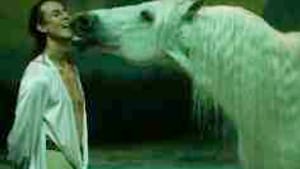Stay in the Loop
BSR publishes on a weekly schedule, with an email newsletter every Wednesday and Thursday morning. There’s no paywall, and subscribing is always free.
Bring on the dancing horses
Cavalia: Man and horse in the Meadowlands

An ancient Arabian proverb, "The horse is God's gift to man," is projected onto the curtain before it rises on the unique spectacle called Cavalia. This two-hour collaboration between highly skilled horses, riders, dancers, acrobats, aerialists, singers, musicians and sound and light designers, reveals both the beauty and the mystery of equines.
Since 2003, when Cavalia began touring cities throughout Europe and North America, the Quebec-based company has performed for sold-out crowds in the 2,000-seat white big top (more than 26,000 feet high) that it constructs at each location. Against a 150-foot-wide backdrop that constantly changes the scene from, say, surrealistic autumn forests and dream-like snowy mountains to intense red desert sunsets, performers dressed in otherworldly hand-stitched costumes perform alongside an array of 50 horses, including Appaloosas, Arabians, American Quarter Horses, Percherons, Lusitanos and Oldenburgs.
Like actors, each horse has an understudy, so no horse performs its demanding routines more than seven times a week. While many of them do the highly technical and labor-intensive Haute Ecole, others are adept at "dressage at liberty." In lay terms, this means they dance either with or without a rider. Unlike the Austrian Lipizzaner horses, whose rigid movements resemble the martial arts, the Cavalia horses are encouraged to express their inner nature and joyfully cavort on stage with their human counterparts.
The show's pacing is perfectly balanced between the ethereal and the earthy. Scenes that illustrate ballet's poetry in motion are contrasted with rough riding in which trick riders gallop back and forth while jumping on and off and over and under their steeds. The most thrilling scenes involve the entire cast— man and beast— performing in unison so that everyone appears to be flying through the air.
Despite (or because of) years of training, many of the horses are natural hams: the audience can actually see them responding to the applause. They've been trained to bow, of course; nevertheless, they appear to genuinely adore the limelight.
But to emphasize the equine aspect of the show is to diminish the extraordinary artistry of the human cast. A more talented group of acrobats and gymnasts would be hard to assemble. Between performances these performers groom and feed the horses (who get 300 pounds of carrots a week), acts of attentiveness that no doubt contribute to the perfect synergy on stage between humans and animals.
What elevates Cavalia to musical theater is Michel Cusson's inspired score. Combining many genres of music, Cusson has composed a work that takes its cues from the rhythm of the horses. Seven musicians behind the curtain must synchronize their music to the tempo of the horses from scene to scene. Choreographers and lighting engineers work together to present a cohesive show. The result is a lavish, mesmerizing and moving production that celebrates the relationship between man and horse.
Since 2003, when Cavalia began touring cities throughout Europe and North America, the Quebec-based company has performed for sold-out crowds in the 2,000-seat white big top (more than 26,000 feet high) that it constructs at each location. Against a 150-foot-wide backdrop that constantly changes the scene from, say, surrealistic autumn forests and dream-like snowy mountains to intense red desert sunsets, performers dressed in otherworldly hand-stitched costumes perform alongside an array of 50 horses, including Appaloosas, Arabians, American Quarter Horses, Percherons, Lusitanos and Oldenburgs.
Like actors, each horse has an understudy, so no horse performs its demanding routines more than seven times a week. While many of them do the highly technical and labor-intensive Haute Ecole, others are adept at "dressage at liberty." In lay terms, this means they dance either with or without a rider. Unlike the Austrian Lipizzaner horses, whose rigid movements resemble the martial arts, the Cavalia horses are encouraged to express their inner nature and joyfully cavort on stage with their human counterparts.
The show's pacing is perfectly balanced between the ethereal and the earthy. Scenes that illustrate ballet's poetry in motion are contrasted with rough riding in which trick riders gallop back and forth while jumping on and off and over and under their steeds. The most thrilling scenes involve the entire cast— man and beast— performing in unison so that everyone appears to be flying through the air.
Despite (or because of) years of training, many of the horses are natural hams: the audience can actually see them responding to the applause. They've been trained to bow, of course; nevertheless, they appear to genuinely adore the limelight.
But to emphasize the equine aspect of the show is to diminish the extraordinary artistry of the human cast. A more talented group of acrobats and gymnasts would be hard to assemble. Between performances these performers groom and feed the horses (who get 300 pounds of carrots a week), acts of attentiveness that no doubt contribute to the perfect synergy on stage between humans and animals.
What elevates Cavalia to musical theater is Michel Cusson's inspired score. Combining many genres of music, Cusson has composed a work that takes its cues from the rhythm of the horses. Seven musicians behind the curtain must synchronize their music to the tempo of the horses from scene to scene. Choreographers and lighting engineers work together to present a cohesive show. The result is a lavish, mesmerizing and moving production that celebrates the relationship between man and horse.
What, When, Where
Cavalia. Directed by Normand Latourelle Through June 27, 2010 under the White Big Top, The Meadowlands (next to Izod Center), E. Rutherford, N.J. (866) 999-8111 or www.cavalia.net.
Sign up for our newsletter
All of the week's new articles, all in one place. Sign up for the free weekly BSR newsletters, and don't miss a conversation.